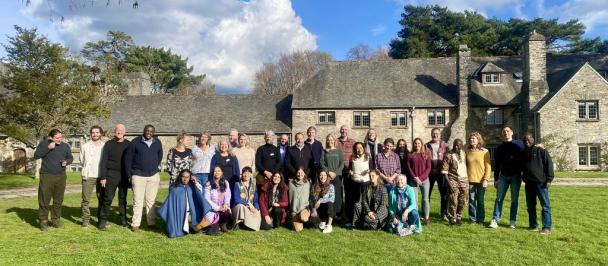In the last of our series of articles on the deeper dimensions of our approach to sustainability, Jane Chun, Program Director of Compassion Institute writes about the importance of being present and aligned with our values. As agents of change, cultivating the skills of mindfulness, compassion, and emotional and somatic intelligence, can not only change ourselves, but the tendencies the world is following.
This blog contains highlights from the online session held by Jane Chun on November, 19th for UNDP. You can access the recording of the full session here.
As development practitioners, we often analyze situations from the viewpoint of observers standing outside looking in at the given system. With a small mindset shift, however, we might realize that we are in fact not outside, but rather a part of the ecosystem contributing to both the problems and solutions, and everything in between.
As agents within the system, we can see that every mundane meeting and conversation related to projects and policies – with government counterparts, civil society partners, colleagues, and others – all create knock on effects in the web of interconnectedness. How meetings are facilitated matters and shapes who is heard or not heard, which decisions are made, and ultimately what interventions look like. Each conversation between colleagues reinforces or dismantles normative power dynamics, and helps to motivate or demotivate individuals. All of these daily interactions collectively shape how individuals feel everyday at work – safe / unsafe, valued and heard / undervalued and invisible – and whether or not they are able to show up as their best selves as they make important decisions with real implications for communities, governments, and international frameworks. And whether or not we are able to live out our values and co-create the kind of society we want, day to day at work and beyond.
During the UNDP session “The Fierce Heart: Showing Up (and Resting) in Compassion in Times of Crisis”, we considered, for example, the different outcomes of a meeting with a project partner we disagree with – on the one hand, when one has cultivated the skills of regulating difficult emotions and is able to stay centered and respond in ways that are helpful to the conversation; or on the other hand, when these skills have not been homed and we are struggling with emotions such as anger or frustration. We all know from experience how one interaction can solidify or break the trust and bonds of a relationship.
There is nothing we can influence but the present moment, and each moment is potent with possibility. It is a marvel that we get to harness this potential every day to show up in ways that are aligned with our personal values, the organization’s mission, and in service of the causes we believe in. To this end, it is vital to cultivate the skills of mindfulness, compassion, and emotional and somatic intelligence – our greatest resources.
In systems thinking, the most powerful lever of change is found at the level of the mind, or mental models – the assumptions, beliefs, and values underlying and driving a system. Mental models are the soil from which all the other elements of a system grow. The list below outlines a simplified example of the iceberg model at work.
Event:
- Your team is developing a 5-year strategic plan through a series of team meetings.
Patterns of behavior / trends:
- During meetings, it is common for certain people to talk, while others don’t or are interrupted.
- These types of strategic planning meetings are commonly scheduled at the last minute, leaving little time for deep and critical conversations.
Systems, structures:
- 5-year strategic plans are required for each program in a certain format.
- Professional grade structure and resulting hierarchies and different levels of job security where some people feel more comfortable presenting divergent views.
Mental models:
- Belief that we don’t have time, the culture of urgency.
- Certain people’s views are more valuable than others (among team members, but also stakeholders. Why, for example, aren’t stakeholders involved in the planning process?).
- Assumption that everyone must use this format. No generative questions around whether this is the best template to use to generate such important plans.
Through training, we can learn to work with our mind and neurophysiology to consciously change and contribute to the system of which we are a part, at the fundamental mental model level. We’re empowering ourselves to take ownership over our minds and nervous systems so that we can be present and contribute in ways that are in alignment with our own values and the mission of our organization; collaborate with colleagues and partners with intention rather than operate on autopilot (going along with how things are done rather than coming from a place of curiosity and innovation), choose our response to situations rather than react from habit, social conditioning, and dominant social norms (some norms we are in fact trying to change through our work!).
Compassion training in particular, equips us to meet stress and challenging situations with a settled mind and heart. In fact, compassion science (an area of neuroscience) has found that compassion activates the reward centers and affiliation areas of the brain. In other words, compassion feels good and imbues us with a sense of connection and belonging, even as we’re confronted with suffering – of others and ourselves. In terms of the autonomic nervous system, compassion allows us to feel safe and at ease, and it is from this place that we are able to be authentically available for others and tend to our own needs in each moment.
Here is one on-the-spot practice that was shared during the session:
Just Like Me
This is a practice one can do before or after interacting with someone challenging, or if you find yourself ruminating about this person.
1. Acknowledge reality, what you’re feeling. Give it a label: frustration, anger, sadness, whatever it may be.
2. Reflect: “Just like me, this person also experiences the ups and downs of life and __________ (fill in the blank; examples include “wants to be well”, “wants to be heard and respected”, “dislikes bureaucracy”).
3. Extend a wish, using your own words: “May you be well”, May you feel at ease”, May you feel heard”.
We know from neuroscience that “neurons that fire together wire together”. What we practice in each passing moment – our thoughts and mental habits – physically changes the structure and function of our brains. The neural pathways that are used repeatedly become stronger and thicker, while those that are not used become weaker and disappear. For example, if I tend to be self-critical, when something goes wrong, my default mental habit will be to treat myself with harshness. With compassion training, I can rewire those neural pathways so that I’m more likely to respond instead with kindness and self-compassion. Like training in physical fitness, it is possible to train our incredible minds and neurophysiology. It is possible to step out of autopilot and the stories we have inherited, and take ownership over how we feel and respond to challenging situations, and how we live out our lives every day.
We owe this to ourselves, to be able to live our lives in alignment with our values and what’s really important to us. We also owe this to the communities and causes we serve, so that we can cause less harm and be as effective as possible in our work, both individually and collectively. In order to affect sustainable transformation in the world, we must remember that we are a part of and a reflection of that world. In the words of Mahatma Gandhi, “We but mirror the world. All the tendencies present in the outer world are to be found in the world of our body. If we could change ourselves, the tendencies in the world would also change.”

 Locations
Locations



